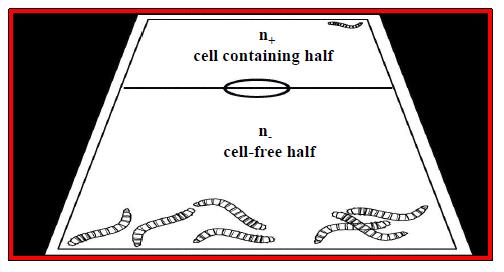WOLFGANG PFEIFFER – FORSCHUNG
Plant growth depends on intracellular and extracellular variables and their linkage, mediated by the cell membrane. Studying various organisms, e.g. autotroph and heterotroph cell cultures of Chenopodium and larvae of Tenebrio, our analyses involve arthropod plant interactions, plant biochemistry, cell physiology, membrane biology, olfactometry and statistics. Global warming causes various environmental stresses reducing plant growth. Thus, we are interested in plant cell responses to salt and hyper-osmotic stress, heat stress and insect biotic stress. The later can be mediated by compounds of the digested insect surface, the so-called elicitors, i.e. chitosans. Our olfactometry analysis of the negative feed-back of plant cells to chitosans revealed an interesting repellent activity (Fig. 1). Since the very efficient synthetic repellent N,N-diethyl-meta-toluamide (DEET) can affect human health, the enhancement and quantification of repellent activity in Chenopodium cells may represent a promising alternative. Multivariate analysis of proton flux in plant cell suspensions after salt stress and metabolite sensing is a further topic. The effects of salt stress, hyper-osmotic stress, ion channel inhibitors, salt stress modulator proline, amino acids, carboxylic acids and plant growth regulators characterize five principal components of extracellular proton flux. A component depending on the antagonistic regulation by ɣ-aminobutyric acid (GABA) and salicylic acid indicates a function of acid sensing ion channels (ASICs) in salt stress sensing. The extreme temperature-dependence of proton flux and its linkage to responses of the actin cytoskeleton are part of this field of research. Our new focus is urban biology in Bangkok (Anchalee Chaidee, Chulalongkorn University, Bangkok), Phayao (Chatchawal Wongchai, University Phayao) and Salzburg (Wolfgang Pfeiffer) in collaboration with Ilse Foissner (Division of Cellular Dynamics, Universität Salzburg). There, relationships between agriculture in paddy fields and mosquito control are of special interest. In total, we design analytical and practical tools for the improvement of living conditions in urban areas of developing countries. Especially, we search for the proof of principle at the organismic level, e.g. repellency (Fig. 1).

Fig. 1 Olfactometry method described by Wongchai C, Chaidee A, Pfeiffer W (2013) Arthropod-Plant Interactions 7: 69-82.




